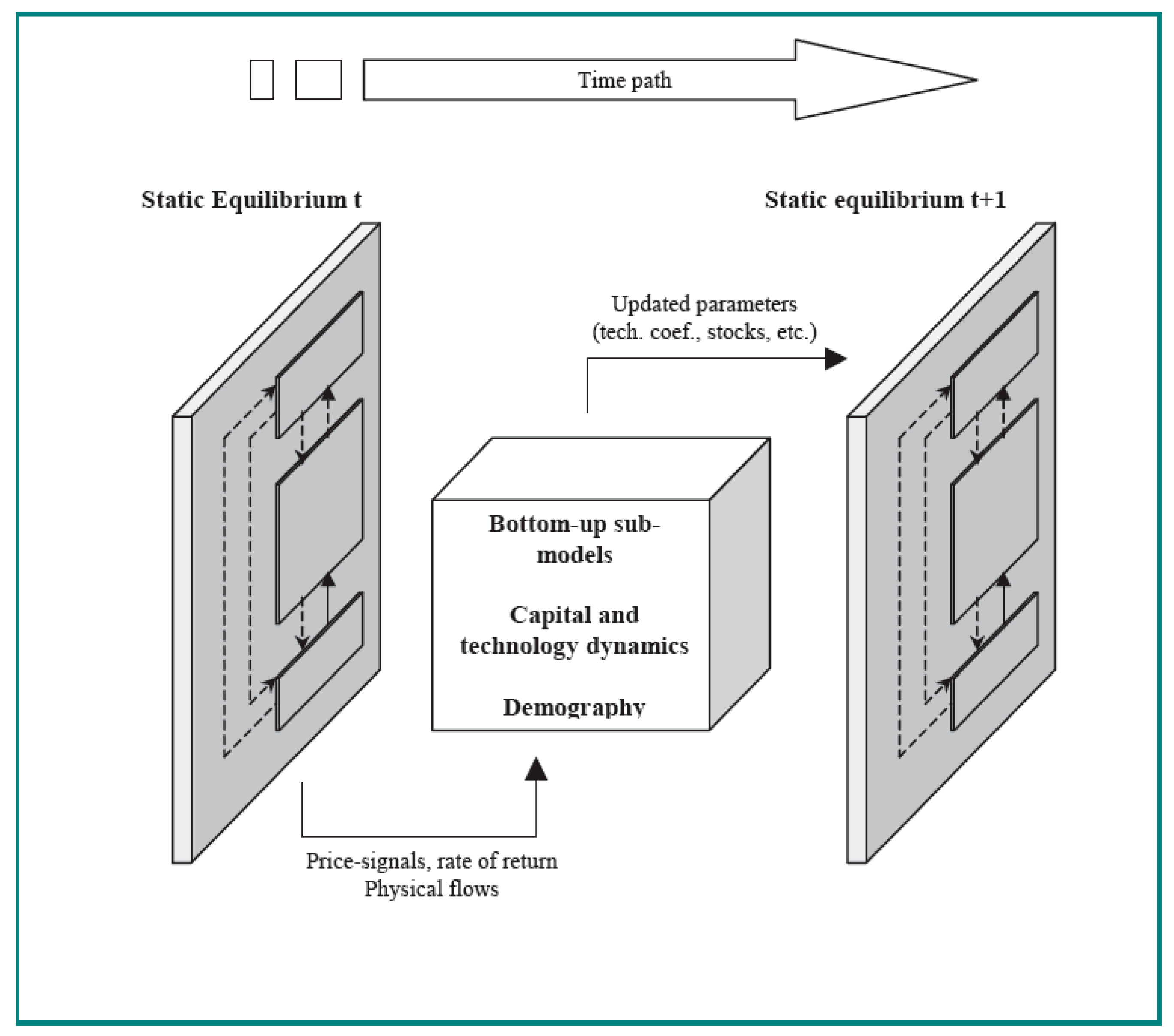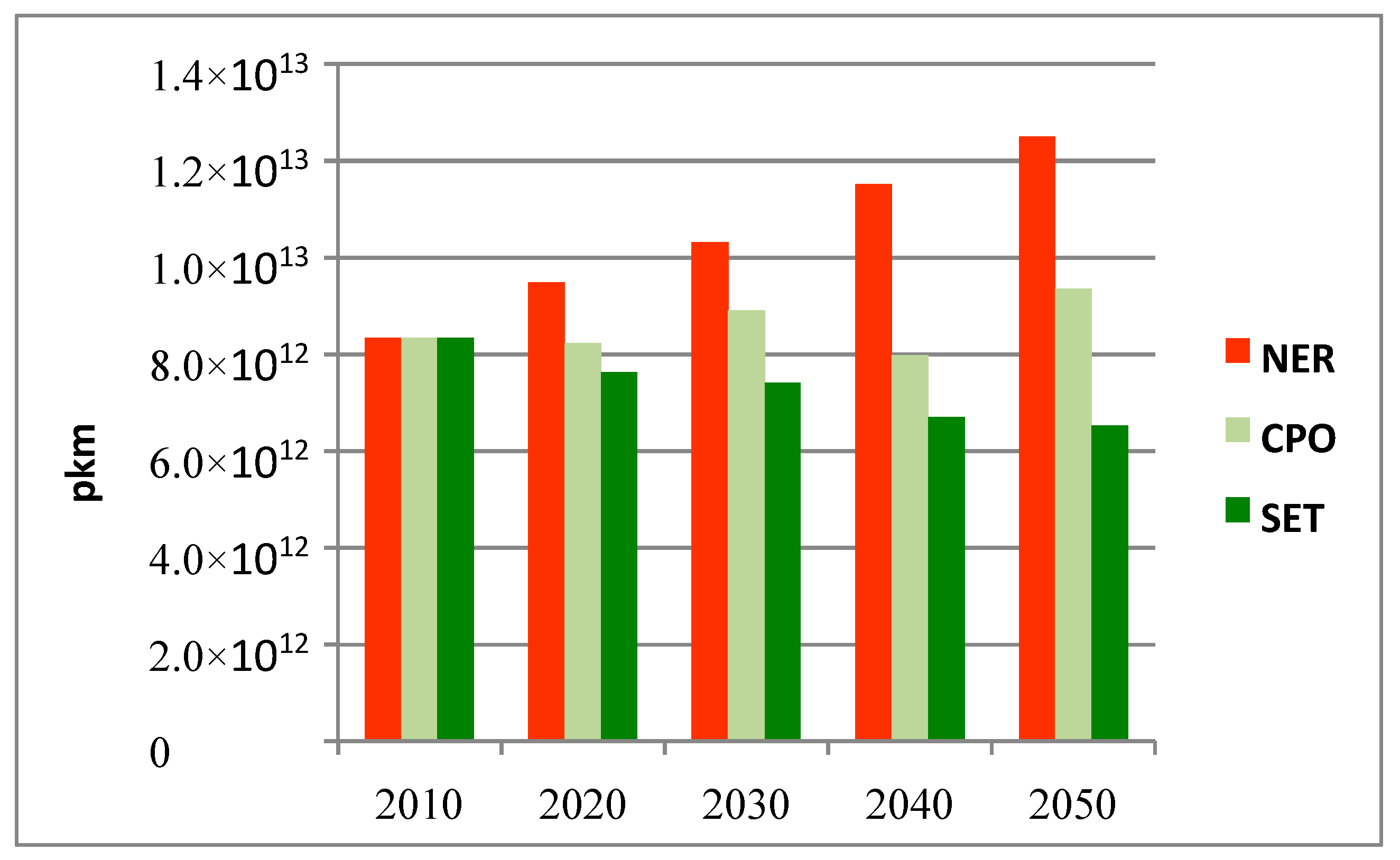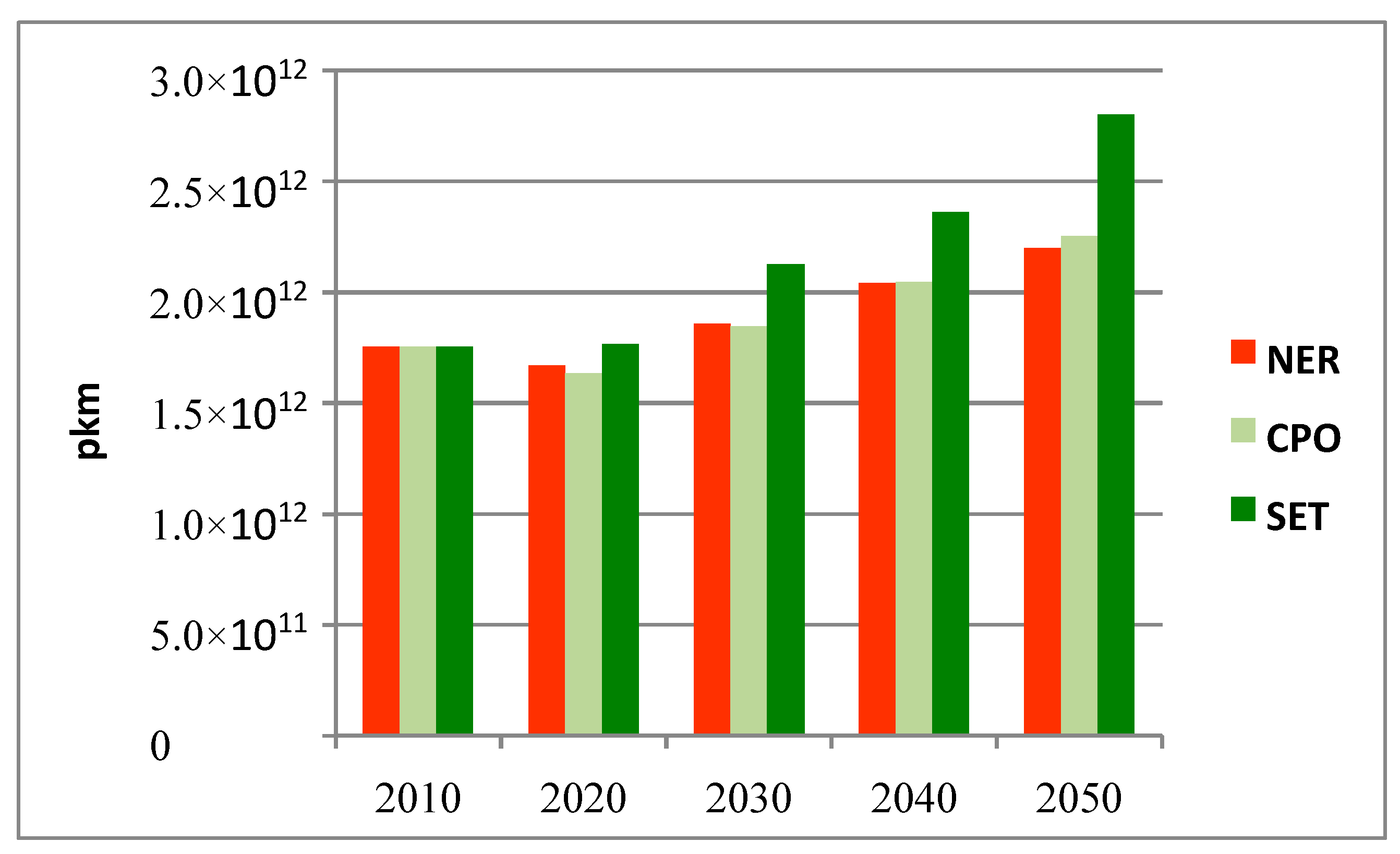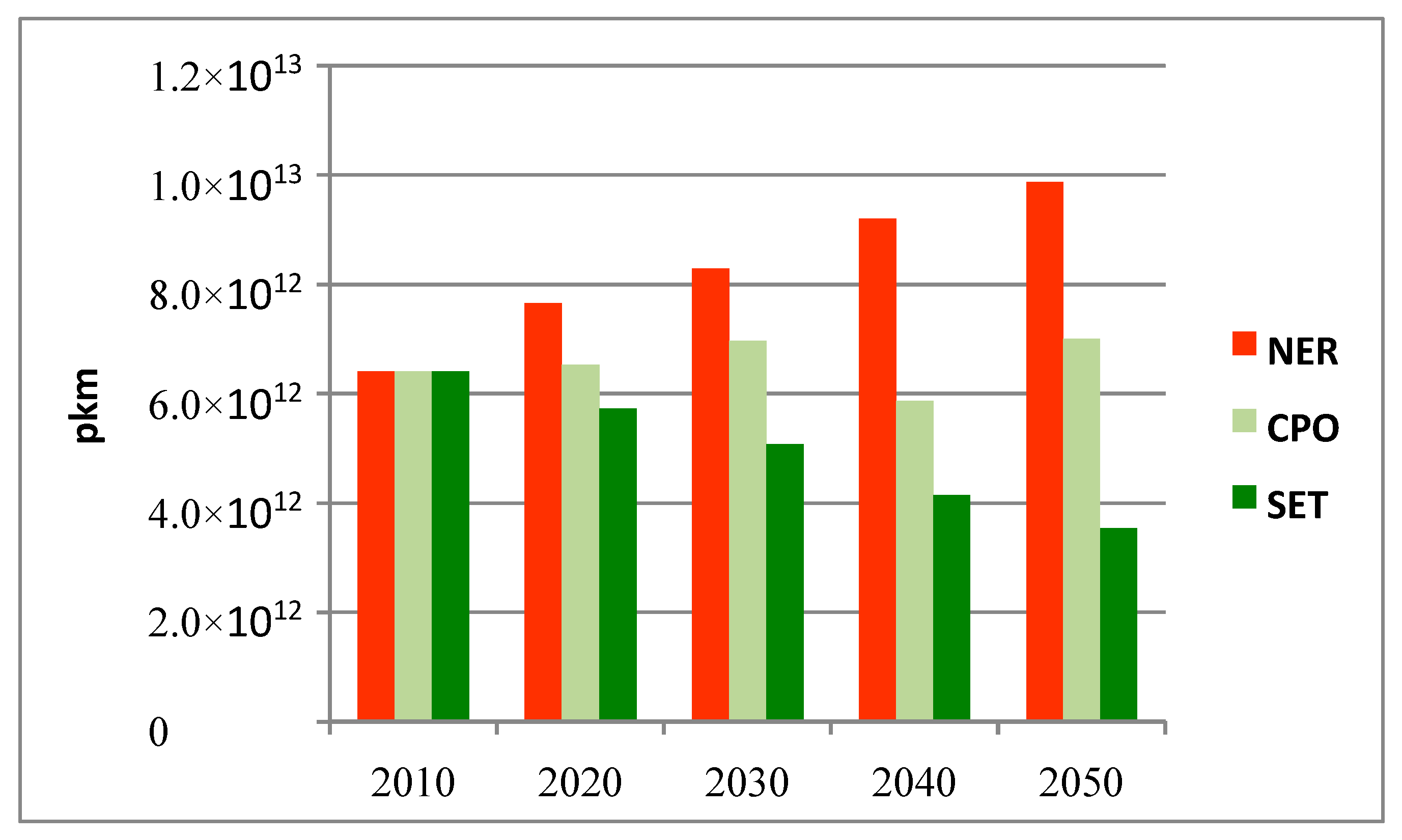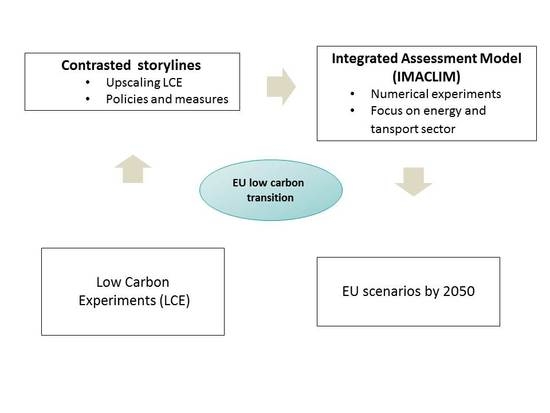4.1. The Modelling Framework
The purpose of E3 models is to analyze global comprehensive climate change mitigation across all environment and sectors, in order to achieve certain mitigation targets. In this section we provide a quantitative assessment of the two narratives described above and translate them into model scenarios to be implemented in the IMACLIM-R model.
As an E3 model, IMACLIM-R is a multi-region and multi-sector Computable General Equilibrium (CGE) that represents the intertwined evolution of economic growth, energy demand behavior and technical systems (
Figure 1). It describes dynamic trajectories in a one-year step through the recursive succession of macroeconomic annual static equilibria and technical dynamic modules (
Figure 1). It includes 12 regions, one of which is the EU28. The model is built not only to facilitate and allow the dialogue between engineers and economists but also to integrate other dimensions (such as environmental policies, human behaviors, urban forms, etc.) that enable a broader multidisciplinary dialogue among a large socio-scientist community (e.g., sociologists, geographers, political scientists, etc.).
By integrating the sectorial dynamics within a macro-economic closure, IMACLIM-R ensures a robust assessment of the challenges posed to the economy by low carbon transition pathways. In particular, it represents the dynamics of structural change (dematerialization of growth patterns) that results from the interplay between technological, institutional and spatial dynamics and patterns [
33,
34,
35] and that is a salient feature of the societal processes underlying low carbon experiments. As mentioned in
Section 2, low carbon experiments relate to changes in technologies and behaviors, in particular regarding energy production and transport practices. IMACLIM-R provides some innovative features to assess the multi-dimensional aspects of these low carbon experiments, beyond the pure technological dynamics that concern the electricity generation and concentrates on aspects related to the “lifestyle” dimension. This is done through an important vector that is linked to territorial and urban zoning policies, as well as to issues related to energy consumption, namely the transportation sector.
Transport is indeed a major issue to consider when dealing with bifurcation in lifestyles [
24]. IMACLIM-R proposes a framework that helps disentangle the role of transport in long-term socio-economic trajectories and the potentials offered by specific measures in this sector to face significant energy and carbon related issues. Contrary to most E3 models that are used for carbon mitigation assessments, IMACLIM-R includes a stylized representation of ‘behavioral’ determinants, as a means of explicitly representing the interplay between transportation, energy and growth patterns [
25]. This is a real added value, since most modelling tools are mainly based upon sectoral approaches that have either a ‘technology-based’ or ‘behavioral-based’ nature [
24]. Indeed, in E3 models, behavioral and infrastructure options cannot easily be operationalized through monetary costs and are entangled with quality of life, norms, and cultural values [
36]. Behavior and the end use of energy are represented as a simple rational choice between available alternatives, though recent tentative to improve behavioral realism of energy consumer in the transport sector [
37].
In IMACLIM-R, the standard representation of transport technologies is supplemented by an explicit representation of the “behavioral” determinants of mobility that allows for an assessment of the potentials offered by specific sectoral measures to face emissions mitigation costs (see
supplementary material). Passenger mobility is considered as a service provided by four transportation modes: terrestrial public transport, air transport, road transport (private vehicles) and non-motorized transport (walking and biking). Public transport” includes both urban public transports (buses, metros… etc.) and inter-city trains, as the model does not differentiate between inter- and intra-city trips. Three types of personal vehicles are represented: standard, hybrid and electrical vehicles. Each vehicle is characterized by its capital cost, which decreases endogenously in function of learning-by-doing process, its operating and maintaining costs and its energy intensity.
The model represents the constrained mobility induced by firms’ and households’ localization choices. This concerns daily travels that households have no choice but to realize in order to satisfy specific travel purposes (essentially commuting, shopping and access to services). They are exogenously represented by basic need parameters (one parameter for each transportation mode), and they implicitly define the spatial distribution of housing and economic activities.
Three freight transportation modes are considered: air, water and terrestrial transport. The freight transportation’s production intensity is measured via input–output coefficients, which define a linear dependence of freight mobility in a given mode to production volumes of a given sector. The higher the production volumes, the higher the freight mobility demand, if no specific policy toward the reduction of this volume is implemented. This representation implicitly captures two important features that drive the modal breakdown and the intensity of freight mobility needs, namely (i) the spatial organization of the production processes in terms of specialization/concentration of production units and (ii) the constraints imposed on distribution in terms of distance to the market and just-in-time processes.
Finally, as mentioned in
Section 3, in the CPO and SET scenarios, the EU adopts its official objectives, leading with respect to 2005 to a 20%, 40% and 80% GHG emission reduction in 2020, 2030 and 2050, respectively. These objectives are translated into a regional CO
2 emission profile which is prescribed exogenously for the period of 2010–2050. At each date, a maximum level of CO
2 emissions from the production and use of fossil energies (coal, oil and gas) in final goods and in transformation processes is set for the EU. The European CO
2 price is then endogenously and annually calculated by the model, so that the increase in the cost of fossil energies leads to a decrease of their use that is consistent with the emission constraint.
4.2. Translation of the Low Carbon Experiments into Model Parameters
Integrating the rich material of low carbon experiments into IAMs represents a main challenge that somewhat exceeds the capacity of the IMACLIM model. As far as we know, there is no study dealing with this issue in the literature; the only studies are limited to place-specific models which consider a small number of locations, investigate infrastructures effects, demand side response policies and urban development [
24,
30]. The value added of a model such as IMACLIM-R is then to identify the mechanisms at play in the long-term dynamics of the low carbon transition. It does this by providing a quantitative assessment of policies and measures that allow for the transition. We thus integrate some of the key dynamics which underlie these low carbon experiments in the macro-economic general equilibrium framework of IMACLIM-R. Since the level of aggregation of the model represents a real gap with the complexity and heterogeneity of the low carbon experiment, we used proxies detailed in the next sub-sections, which provide a first-order approximation of their economic impact.
4.2.1. Within the Transportation Sector
Behavioral Side
The two alternative scenarios are distinguished by the nature of the transport-related policies that are considered or introduced in parallel to the carbon tax.
The CPO scenario considers a continuation of current trends of investment choices driving mobility demand, i.e., no changes with respect to those implemented in a benchmark scenario that considers no climate policies, the so-called No Emission Regulation (NER) scenario. It is assumed in particular that:
- (i)
Constrained mobility evolves proportionally to total mobility in order to (i) take into account all basic mobility purposes, such as commuting, shopping and access to services, and (ii) have a proxy in order to represent the increase of urban sprawl as households gain better access to transport modes with increased performance. The ratio of the constrained mobility over the total households’ mobility demand is set to 50% throughout the studied period. This is a conservative assumption that does not consider measures for reducing constrained mobility and overcoming inertias in the transport sector.
- (ii)
The allocation of investments in transportation infrastructures follows modal mobility demand and is implicitly driven by the objective of avoiding congestion. This means that for each transportation mode, the construction of infrastructures (road, railways and airports) is linked to the increase of the mobility demand of this mode (e.g., the more pkm are satisfied by private vehicles, the more roads will be built).
- (iii)
The organization of production/distribution processes remains similar throughout the period, which means that the freight transport’s production intensity remains constant. For instance, when transportation costs increase due to energy or carbon price increases, the dependence of the production processes on transport remains constant.
In the SET scenario, the carbon pricing policy is complemented by measures to change the ‘behavioural’ determinants of transport in the course of the low-carbon transition (both directly and indirectly). Spatial planning policies and changes in investment decisions for long-lived transport-related infrastructures are represented. Indeed, urban characteristics can significantly impact transport demand (e.g., by incentivizing modal shifts from car transport to cycling), building size and behaviors [
36]. This is done in a very synthetic way, as it encapsulates rich policy packages that are implemented at different spatial scales. The measures affect three crucial determinants of transportation activities that are explicitly represented in IMACLIM-R: the constrained mobility, transport capacities and freight transportation’s production intensity. More precisely, we assume:
- (i)
A progressive reduction of households’ basic mobility from 50% of total mobility in 2020 to 30% in 2050 and after (vs. a constant 50% in the CPO and NER scenarios). This represents a spatial reorganization at the urban level (denser cities) and the implementation of soft measures in less mobility-dependent conglomerations.
- (ii)
Shifts in the modal structure of investments in hard transportation infrastructures favoring public modes instead of private vehicles (walkable neighborhoods, public transit systems, highways, buildings). This is done through a limitation of building infrastructures for road and air transport, which induces a saturation of the corresponding transportation capacities. We assume a maximum threshold to the mobility offered by these two modes targeted at 3500 km/capita and 1000 km/capita, respectively, instead of there being no limitation in the CPO scenario [
25].
- (iii)
Reorganizations of production/distribution logistics inducing a decrease of freight transportation needs (e.g., improved back loading, more space-efficient packaging, shorter or more transport-efficient ordering cycles, etc.). A 2% yearly decrease of the freight transportation’s production intensity is assumed in the SET scenario.
Technological Side
When it comes to low-carbon end-use technologies in the transportation sector, two contrasted assumptions have been considered, whether it be for passenger mobility (e.g., the penetration of electric vehicles) or for freight mobility with parameters related to the energy efficiency of freight, or whether it be for both of them (e.g., biofuels penetration). These assumptions are translated into specific parametrizations.
For instance, as shown in
Table 1, the penetration of vehicles in the model follows a classical S curve of market diffusion. The parametrization of the model allows, in the SET scenario, for the strong penetration of electric cars to reach a maximum 50% of the total car fleet at the end of the period, compared to 20% in the CPO scenario. The freight fuel consumption elasticity to fuel prices is also higher in the SET scenario.
4.2.2. Low Carbon Electricity Production Modes
Like for transport technologies, the two climate policy scenarios have been differentiated according to contrasted assumptions concerning the availability and diffusion of some low-carbon technologies for the electricity generation. The lever for action used in this paper to translate the low carbon experiments has been the renewable resources, with a particular focus on Photovoltaic (PV) and Wind (Onshore and Offshore) technologies. As described in the corresponding narratives (
Section 3), the SET scenario is much more optimistic than the CPO scenario in terms of the penetration and diffusion of the renewable technologies. In this scenario, the parametrization allows for a higher availability with lower costs and higher potentials for PV and wind technologies (see
Table 2).
